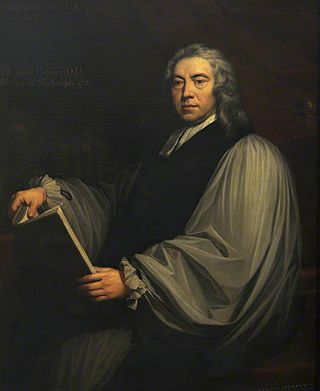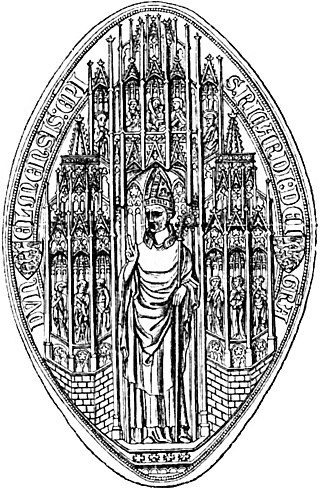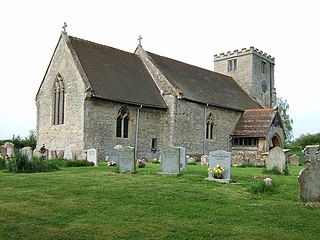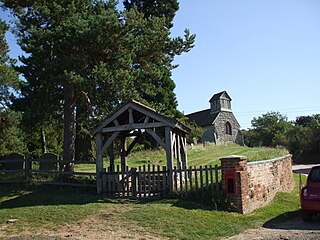Related Research Articles
Sir Thomas Duffus Hardy was an English archivist and antiquary, who served as Deputy Keeper of the Public Record Office from 1861 to 1878.
Anne de Mortimer, was a medieval English noblewoman who became an ancestor to the royal House of York, one of the parties in the fifteenth-century dynastic Wars of the Roses. It was her line of descent which gave the Yorkist dynasty its claim to the throne. Anne was the mother of Richard, Duke of York, and thus grandmother of kings Edward IV and Richard III, great-grandmother of Edward V.

Anthony Wood, who styled himself Anthony à Wood in his later writings, was an English antiquary. He was responsible for a celebrated Hist. and Antiq. of the Universitie of Oxon.

Thomas Tanner was an English antiquary and prelate. He was Bishop of St Asaph from 1732 to 1735.

Richard de Bury, also known as Richard Aungerville or Aungervyle, was an English priest, teacher, bishop, writer, and bibliophile. He was a patron of learning and one of the first English collectors of books. He is chiefly remembered for his Philobiblon, written to inculcate in the clergy the pursuit of learning and the love of books. The Philobiblon is considered one of the earliest books to discuss librarianship in-depth.

Shabbington is a village and civil parish in west Buckinghamshire, England, about 3 miles (5 km) west of Thame in neighbouring Oxfordshire, and 7 miles (11 km) southwest of Aylesbury.

The title Baron Greystock has been created twice in the Peerage of England. It was first created when John de Greystock was summoned to parliament in 1295.

Compton Verney is a parish and historic manor in the county of Warwickshire, England. The population taken at the 2011 census was 119. The surviving manor house is the Georgian mansion Compton Verney House.

Richard of Wallingford (1292–1336) was an English mathematician, astronomer, horologist, and cleric who made major contributions to astronomy and horology while serving as abbot of St Albans Abbey in Hertfordshire.
Wallingford Priory was a Benedictine priory dedicated to the Holy Trinity in Wallingford in the English county of Berkshire. Nothing remains of Holy Trinity Priory, which is believed to have stood on the site of the Bullcroft recreation ground off the High Street.
William of Wallingford was the 47th abbot of St Albans Abbey. He was a Benedictine monk at Holy Trinity Priory, Wallingford, Berkshire, England and like John of Wallingford and Richard of Wallingford, moved from this cell of St Albans Abbey to the abbey itself. He was a favourite of John Stoke, 44th abbot of St Albans, also from Wallingford. On his deathbed in 1451, Stoke was supposed to have given William and Thomas Wallingford, his senior chaplain, charge over 1000 marks but after his death they could only account for 250 marks. The abbot John Wheathampstead who succeeded Stoke suspected the two over the money. Nevertheless, William of Wallingford was later appointed abbot in 1476, after the death of William Albone, apparently for his financial acumen, at a time when the abbey was in debt. William of Wallingford managed to get rid of the debt whilst also spending on the abbey. He built the high altar known as the Wallingford Screen at a cost of £733 and completed the chapter house. The statues on it were destroyed during the Dissolution but were replaced in Victorian times.

The Randolph family of Virginia is a prominent political family, whose members contributed to the politics of Colonial Virginia and Virginia after statehood. They are descended from the Randolphs of Morton Morrell, Warwickshire, England. The first Randolph in America was Henry Randolph in 1643. His nephew, William Randolph, later came to Virginia as an orphan in 1669. He made his home at Turkey Island along the James River. Because of their numerous progeny, William Randolph and his wife, Mary Isham Randolph, have been referred to as "the Adam and Eve of Virginia". The Randolph family was the wealthiest and most powerful family in 18th-century Virginia.
The office of High Sheriff of Somerset is an ancient shrievalty which has been in existence since the 11th century. Originally known as the "Sheriff of Somerset", the role was retitled on 1 April 1974, under the provisions of the Local Government Act 1972.
The High Sheriff of Hertfordshire was an ancient Sheriff title originating in the time of the Angles, not long after the foundation of the Kingdom of England, which was in existence for around a thousand years. On 1 April 1974, under the provisions of the Local Government Act 1972, the title of Sheriff of Hertfordshire was retitled High Sheriff of Hertfordshire. The High Shrievalties are the oldest secular titles under the Crown in England and Wales, their purpose being to represent the monarch at a local level, historically in the shires.
This is a list of sheriffs and high sheriffs of the English county of Warwickshire.
The Priory of St. Andrews of the Ards (Blackabbey) was a Benedictine Abbey in County Down, Ireland. It was founded by John de Courcy as a daughter-house of the alien Benedictine Priory at Stogursey in Somerset, England. As Stogursey Priory was itself a cell of Lonlay-l'Abbaye in Normandy, Blackabbey also became affiliated to that house. In around 1356 the Blackabbey, with all its lands, was effectively dissolved and assigned by Lonlay to Richard FitzRalph, Archbishop of Armagh and his successors, under whom it continued.

Morton Bagot is a small village in the Stratford-on-Avon District of Warwickshire, England. It lies about 1.5 miles (2 km) east of the Birmingham-Alcester road, the modern A435 and Roman road Ryknild Street, 6.5 miles (10 km) north of Alcester, 9.5 miles (15 km) from Stratford-upon-Avon and 12 miles from Warwick, across the valley of a small brook, flowing south-east to join the River Arrow.

The House of Stratford is a British aristocratic family, originating in Stratford-on-Avon between the eleventh and thirteenth centuries. The family has produced multiple titles, including Earl of Aldborough, Viscount Amiens, Baron Baltinglass, Viscount Stratford de Redcliffe and the Dugdale Baronets. The Viscount Powerscourt and Baron Wrottesley both claim descent from this House. Historic seats have included Farmcote Manor and Stratford Park in Gloucester, Merevale Hall in Warwickshire, Baltinglass Castle, Belan and Aldborough House in Ireland, and Stratford House in London, amongst many others. The house was at its most powerful in the fourteenth, sixteenth, and eighteenth centuries.
William Binham was an English theologian and Benedictine prior of Wallingford in Berkshire. He took the degree of D.D. at Oxford, where he was for a time intimate with Wycliffe, against whom he afterwards wrote Contra Positiones Wiclevi.
References
- 1 2 3 Great Munden or Munden Furnivall
- ↑ Dugdale 1846, p. 278.
- ↑ Bodleian Library 1878, p. 17.
- ↑ Family Search/John Moor
- ↑ Hockey et al. 2007, p. 969.
- ↑ North 2007, pp. 24, 25.
- ↑ Lee 1896, p. 205.